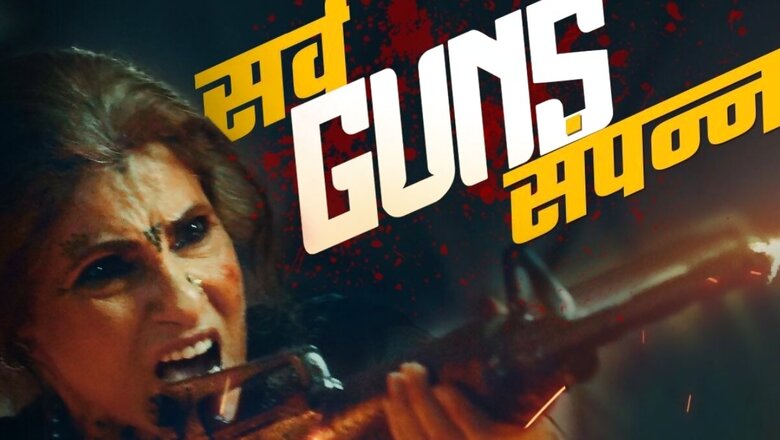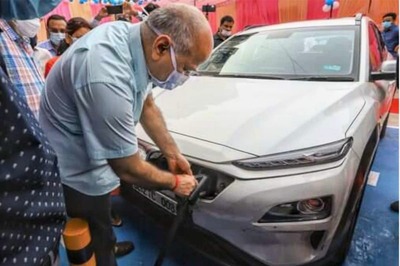
views
For decades, we have been made to believe that gun, gore and glory is a man’s territory. Cinema has, time and again, reinforced a narrative wherein only men have the right to hurl expletives, wield revolvers, have sexual desires, control underbellies, possess power and manipulate financial decisions. But, like a gush of fresh air, filmmaker Homi Adajania turns the table, challenges the status quo and helms a story about power play with women at the forefront with Saas Bahu Aur Flamingo.
While it is all kinds of invigorating, it is not shocking because he has consistently sketched women, who are flawed and fragile, vulnerable and vindictive and pacified and powerful. And veteran actor Dimple Kapadia has been the common thread connecting all his films. While Being Cyrus (2006) sees her as a grumpy woman and Cocktail (2012) as a gregarious Punjabi mother, her Rosie in Finding Fanny (2014) is funny, wise and almost even desperate. And with Saas Bahu Aur Flamingo, Dimple takes her magnificence a notch higher.
Taking his nuanced understanding of women forward, Homi brings alive a bunch of them as they revel and sometimes even rebel against the backdrop of drugs and gun powder in his latest outing. Most importantly and thankfully, he redefines the dynamics between a mother-in-law and daughters-in-law, mother and daughter and mother and sons in a desi household like never before. Here, the matriarch’s words are sacrosanct and she trusts and empowers the other women in her family to be financially independent and take her legacy forward. The men, however, are deliberately kept in the dark about all business dealings because they are too inept and brittle to take on the responsibility of running an empire. And this being told through the lens of a male filmmaker is refreshing, to say the least.
Saas Bahu Aur Flamingo is set in the borderlands six hours away from Runjh airport in Rann Pradesh. It revolves around Savitri, fondly referred to as Rani Ba, and her family. Apart from being the matriarch of the family, she is also a mother-figure to many widows. She has taken them under her wings and have empowered them to earn their own livelihoods without having to depend on anyone else. Together, the women run a drug cartel under the garb of a handicraft business called Rani Cooperative and supply cocaine under the euphemism of flamingo to Delhi, Mumbai, Europe and the Middle-east. Savitri’s team of second-in-command includes her daughters-in-law, Kajal and Bijli, and daughter, Shanta. While Kajal takes care of the day-to-day deals, Bijli is the accountant of Rani Cooperative. Shanta, on the other hand, works in the lab and is the brain behind concocting flamingo. Dhiman, Rani Ba’s adopted son, is also an important part of this business.
Her sons, Harish and Kapil, live in the USA and don’t have the slightest idea about the drug cartel run by the women in their family. Rani Ba asks them to wait till Janmashtami, the day when she’s going to announce the name of the official heir to the business. Running parallel to this track is that of Monk, Rani Ba’s ultimate nemesis, who runs a cartel in North-Eastern Ridge. Also thrown into this mix is ACP Proshun, who gets a whiff of the nefarious dealings happening at Rani Cooperative. What unfurls on the days leading up to Janmashtami as the borderlands become a bed of power play and how the messiness of relationships surfaces, form the rest of the story.
Clinically, Saas Bahu Aur Flamingo is a trailblazer. Here too, Homi keeps his signature stamp intact – the element of quirkiness. Kudos to him for creating every character with a fair amount of finesse! But what makes you root for them is their eccentricity. Their reactions to situations will crack you up every now and then. Most of the times, you won’t agree with them and they may even seem bizarre. And that’s why they stand out, particularly Shanta. Her problems are real and complicated but her demeanour and choices make her an oddball. While this may be a plus for most parts, it also leaves many questions unanswered. We don’t know why Shanta sports an androgynous and careless fashion sensibility despite growing up within the confines of a haveli in Rann Pradesh amid all the traditional outfit clad women. What makes Kajal and Bijli the people they are today also don’t get established.
What, however, adds to the esoteric quirks is the background score. The seamless amalgamation of folk music and new age dub-step sounds render a chic quotient to both the dramatic and action sequences. Having said that, the theme music of Saas Bahu Aur Flamingo seems heavily inspired from that of The White Lotus. The costume department and the set designing team deserve brownie points for rendering an element of authenticity to the backdrop against which the show is set. Another week link in the series is its length. With a total of eight episodes with an average run-time of about 50 minutes, Saas Bahu Aur Flamingo is made to drag quite often. A crisper narrative would have definitely helped the genre bloom.
What stands out are the action sequences performed by the women. These women don’t wear latex bodysuits and capes and don’t carry the most advanced guns. True to their roots, they wield desi daggers and pistols to bring down an entire army of rowdy goons. These scenes fill you up with awe and might make you wonder why we don’t see more of women-centric action spectacles. Known for his urban stories, Homi attempted to reinvent himself with Angrezi Medium (2020), a story based in a small town. With Saas Bahu Aur Flamingo, he penetrates further into the hinterlands. Though the show makes for a novel idea and execution, the original ‘Homi Adajania’ urbane template spills over in bits and parts. Case in point, Kajal’s sartorial sensibilities and Shanta’s whole life.
Dimple is the star of the show. She plays Savitri with a remarkable strength, grace, dignity and rawness. It is incredible how she manages to nail every character even with the most implausible shades and make them seem so convincing and admirable! She ably shoulders the show with a powerful charisma and screen presence that, inarguably, steals the thunder from everyone else. Radhika Madan as Shanta sinks under the skin of her unpredictably bizarre but sensitive character with aplomb. Having already proved her mettle and versatility, Shanta is another interesting addition to her impressive oeuvre.
Isha Tanwar, who essays Bijli, plays out the complexities in her characters and relationships with a mellowed elegance. Her scenes with Monica Dogra’s Naina are beautiful. And kudos to Monica for boldly playing with gender roles in her career! Angira Dhar as Kajal does a good job but it is perhaps the only character that remains under-cooked. She doesn’t seem to fit into the milieu of the story and though we get to catch a glimpse of her background, it doesn’t really help establish her character well.
Ashish Verma and Udit Arora deserve a special mention. Varun Mitra and Jimit Trivedi deliver good performances. But among the men, it is Deepak Dobriyal who is sure to blow your minds away. It’s sheer delight watching him play the eccentric and ruthless antagonist with so much grit. Monk helps him unravel every artistic vein and he’s so convincing that you almost end up hating him. Hopefully, this will mark the beginning of a new chapter in his career.
Go for Saas Bahu Aur Flamingo if you have ever wished for a desi spin-off of Pablo Escobar. It is raw, grimy, gritty, badass and definitely raises the bar for women-led content.
Read all the Latest Bollywood News and Regional Cinema News here


















Comments
0 comment